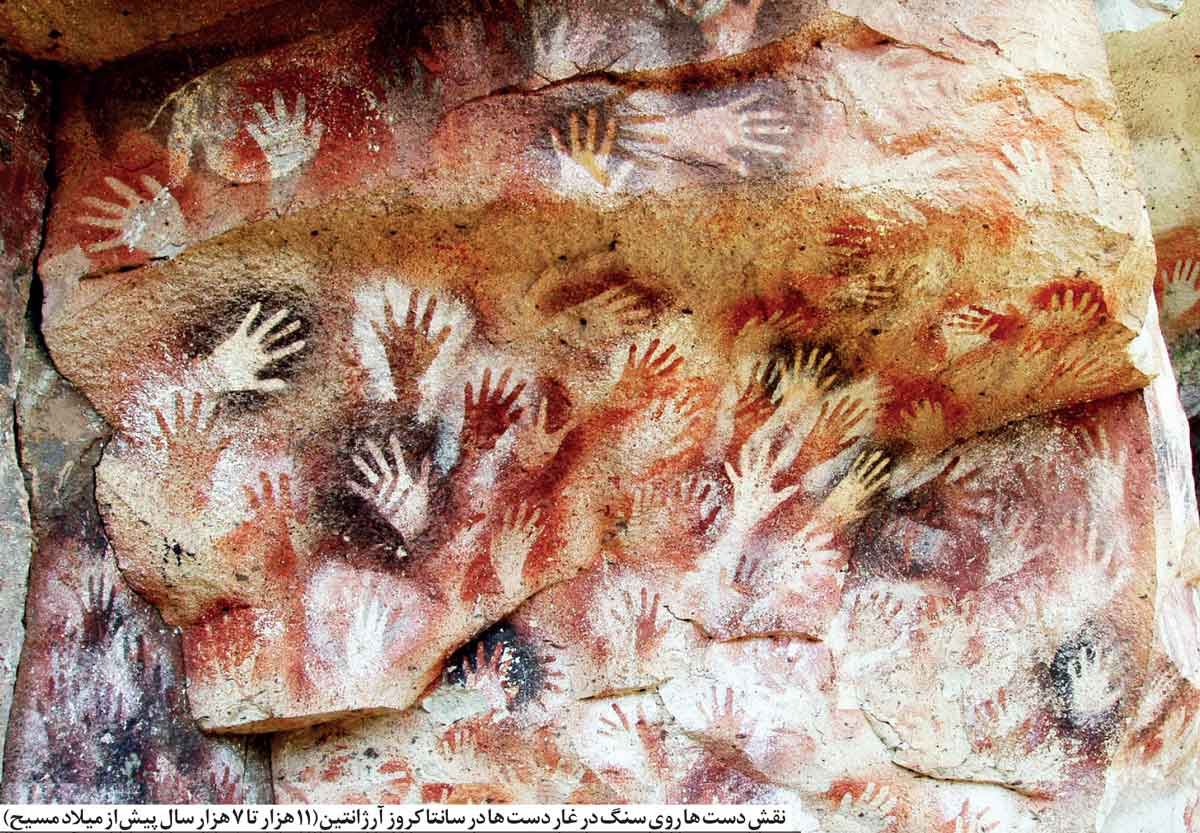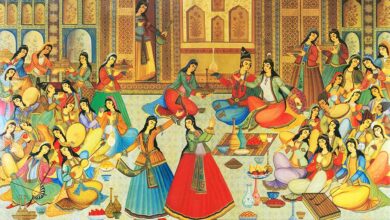Society’s Arts and Sociology of Art

Alireza Karimi Saremi: The beginning of art is a flight of thought from humans who began life in Africa two and a half million years ago, made their first stone tools, and in the millennia later wrote their inner ideas on cave walls. The beginning with the emergence of Neanderthals and intelligent humans.
It is amazing to imagine how man lived 200,000 years ago and how he saw the world around him. Many researchers and scholars around the world have tried over the years to answer many questions in this regard. For this purpose, they studied the science of anthropology through archeology. In The History of Civilization, Will Durant refers to the discovery of the Altamira Cave in northern Spain around 16,000 BC and examples of human art at the time. The role of a wild bull, which is very well drawn and painted, is an example of the art of intelligent humans.
Perhaps we should consider these paintings as representative of the original art that has been left to us by the intelligent man with the initiative and in order to create the expression of mentality. Human beings who had ideas and thoughts according to the surviving works. Creativity in making functional stone tools to defend oneself and one’s family and drawing a striking picture of the animals around one another.
Extensive research still leaves many unanswered questions, such as the amazing 9,000-year-old image of a hand carved on a stone wall in a cave called the Hands Cave in Argentina, as if these lifeless hands were looking for something. They are stretched out to the viewer and perhaps represent a kind of group life at that time.
The article does not mean merely dealing with the history of human civilization, but what has been written can be a prelude to dealing with the art of ancient societies that may have inadvertently created images and art objects, and addressing them today helps scholars and paleontologists to understand art.
But what is mentioned in various historical books is the instinctive interest of early humans in group life, because they themselves were the founders of a small society. Maybe all these group behaviors and the use of yellow, red and blue colors for makeup and beauty, and maybe they scared the enemy and maybe they learned all this from the animals and nature around them. But what can be said with certainty is that the ancient humans imitated the cries and chirps of animals and their searching and piercing their beaks, and in the meantime they realized singing and dancing.
Therefore, it must be said that the first reason for the emergence of art was the interest of ancient people in beautifying themselves.
Following these ups and downs of thousands of years and unparalleled evolution, a sense of power-seeking and increasing wealth turned man into ruthless warriors and hard-hearted rulers. Until the new era began.
Around 1400 AD, what was important was independence, ability, intellect, knowledge and skill. In the meantime, they no longer asked anyone what position, profession, religion, or country they were from, but first asked, “What can you do?”
It was in the Renaissance that a new era of fundamental change in human thought took place. They discovered new beauty in the world, in the sky and trees, in humans, in flowers and animals, and were always looking for new inventions such as printing.
In the middle of the eighteenth century, it was as if a new world, far removed from medieval prejudices and perversions, called man to modern life. Society was formed with a clear definition and led to the formation of social institutions. Hence, the cities developed and had a new order and military.
Anthony Giddens believes: “The development of today’s cities has had a profound effect, not only on habits and behaviors, but also on patterns of thought and feeling. In the meantime, the emergence of social movements can be defined as a collective effort to advance common interests, or to achieve a common goal, through collective action outside the realm of formal institutions.
It should be noted that with the expansion of cities and the creation of new societies, the use of cultural and artistic factors, plays a key role in promoting the level of consciousness and insight of members of society.
“Our personality and vision are strongly influenced by the society in which each of us lives by chance. At the same time, in our everyday behaviors, we actively recreate and reshape the cultural and social contexts in which our activities take place. “So the personality of individuals is in some ways the product of civilization and social institutions, that is, the personality flourishes and grows according to the pattern of society.” That is why the custodians of culture and art in progressive and advanced societies have always used the spread of art to achieve innovation and creativity and create an ideal society. For example, by designing and building museums, exhibitions and various art festivals and specialized art education centers, they encourage the community to attend these events in order to strengthen the visual vision and the opportunity to think and reflect. Because art comes from the background of social life and is one of the main factors in social life.
Undoubtedly, many people in today’s Iranian society, even those with higher education or in the affluent and middle class, are alien to art; Because they are not properly educated with a codified program and are not familiar with art. Because the custodians of society, what an amazing role art can play in the management of urban life to make fundamental changes in thinking, awareness, structural reform of the community system and, consequently, reform of social behavior and mental peace of citizens of a society, they are unaware.
If we think about the role of art in society, we will get an understanding of how society works. The general attitude of a society” towards art will say a lot about that society. By examining the role of art in a given society, one can understand the course of affairs and the performance of that society. In the society in question, does art, in its various forms, play a pivotal role or is it merely marginal? Are different groups of people involved in the production of art or are they passive? Do specific art audiences belong to different sections of society or do they only belong to specific groups? Are art forms available to everyone or are they just the absolute property of elites?
By answering such questions, one can realize important aspects of the nature of a society. In other words, meditation in art is one of the most appropriate ways of meditation in society. By examining the relationship between art and society, art can be understood in a deeper and better way than is usually possible in other ways. This is the main claim of the sociology of art. “
The special role of art is not to break open doors, but to be the key to closed doors; Because, when the artist reveals new facts, it is not only for himself; It is for others and for all those who want to know what world they live in, where they come from and where they are going.
Art is like an ointment to endure difficult conditions, conditions that some people have suffered and it is not possible to improve or overcome them easily.
Alain de Botton and Armstrong say: Art will not be considered good or bad in itself, but it will be good or bad for us as long as it helps to compensate for our weaknesses, this is the therapeutic function of art.
But here are some questions:
How much is the art of Iranian society today? What is the role of the organizations in charge of culture and art in the field of art history and the importance of art? How much of the country’s financial credits are spent annually on cultural and artistic infrastructures for the art of society? Does the country’s cultural and artistic system believe in strengthening culture and expanding art in order to create a progressive atmosphere in society? Have the arts and craftsmen designed and explained the timed vision?
Without a sociological perspective, our understanding of art, society, and ourselves would be incomplete. The sociological study of art, at its most fundamental level, means the study of the relationship between art and society.
The sociology of art specifically raises the question of how institutions and social relations affect the production, distribution, and perception and reception of works of art.
The social conditions of art perception and perception have been one of the central questions of Pierre Bourdieu, the famous French sociologist, in the sociology of art since the mid-1960s. In his love of art, Bourdieu analyzes historical and social factors that play a decisive role in shaping the completely different interests of different social classes visiting art galleries, as well as praising high art / culture. In his view, works of art are messages whose discovery and interpretation of codes requires prior knowledge. His survey shows that working-class members and people with a peasant mentality are less likely to visit galleries and the reason for this, according to his theory, is that they do not have the codes needed to understand the meaning of the works of art displayed in such places. The survey also showed that there was little or no formal training in the principles of understanding and praising art. Schools have refused to fulfill their responsibilities and have failed to provide the necessary facilities for equal access for their students, regardless of their social class, to high art / culture.
I will tell you about my objective experience in this regard. In 2004, I had an exhibition with a group of artists from different fields of art at the National Museum in Minsk, the capital of Belarus. During the exhibition days, a number of elementary school children were brought to the museum every morning, and interestingly, their instructor taught the children how to enter the museum before entering the exhibition. I was amazed to see the children walking silently and on their toes, asking questions very calmly with their instructor. This was a clear and valuable example of teaching children to enter and visit museums and exhibitions.
Now look at the same issue in Iran. When I was in charge of the international section of the Tehran Museum of Contemporary Art, not only did nothing like this happen, but if a family came to the museum with their children, they mistaken it for a park and it was a place to eat snacks and run, play and Screaming children, without the slightest warning from parents. Therefore, it is necessary that careful educational planning be designed and implemented by those in charge of education.
One of the main factors that cause the cultural and artistic growth of a society is the selection of thoughtful managers with academic backgrounds to employ elites in the field of culture and art. Because by creating a think tank, which consists of real masters of art, sociologists, psychologists and researchers, etc., they can think of a solution and proceed with comprehensive planning with full knowledge.
Applying sociological science can show the right path in the next steps to know a society. Sociology is a quantitative social and scientific science that studies society and the human system, the relationship of individuals with each other and with society, institutions and social structures, and among other issues, the issue of human communication and how to convey and create meaning in the context of society. It is serious. The sociology of art examines how different human groups work together to create what we call art. How they use works of art and what is the role and place of art in their lives.
Sociological activities of art can be characterized by four trends:
Sociologists examine the role of organizations and institutions that have a positive or negative impact on the production of works of art. They examine the performance of art creators and the ways in which collectors and supporters of artists are identified. They determine the extent to which new and diverse audiences of works of art have access to and use works of art, as well as research into the role of art in reproducing social status. To train an aesthetic sociology, they analyze social roots and criteria of taste, and research artistic interpretations and evaluations of social factors.
For this purpose, in sociology of art, a term is used as mediation and represents anything that interferes between a work and its acceptance. A work of art does not find a place as a work of art, except in the light of the collaboration of a complex network of social activists: without merchants who trade it, without collectors buying it, without critics to review it, without experts identifying it, without brokers putting it at auction, without curators who preserve it for posterity. Without restorers to repair and clean it, without exhibitors putting it in the public eye, and without art historians, who write commentary on it, the artwork will not find spectators to look at.
Arnold Hauser believes that to understand works of art, it is enough to know the economic and social conditions in which the work of art was born. In this approach, the social status of the artist is of special importance and, along with the conditions of society, plays a decisive role in works of art.
Finally, knowing the evolutionary process of mankind, which has taken place at the beginning of life to this day, it can be acknowledged that humans have always been interested in influencing and presenting their thoughts, either as motines on the walls of caves or by creating artworks on the walls of galleries and museums, on their community and society. Although in different times, the type of human thought and insight has varied, but artists and their artworks have always had an important place in strengthening a new thought in order to enhance the level of life of a society.
Therefore, ignoring art and artists will make life soulless and people unmotivated and crooked, and will be a deterrent to the happiness of a society and thinking about a better life.









